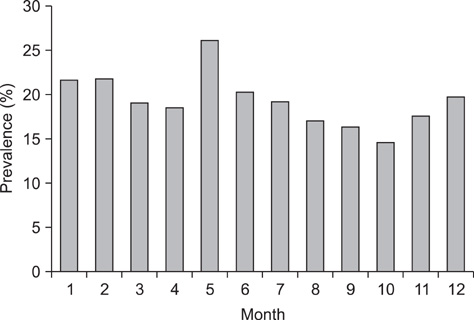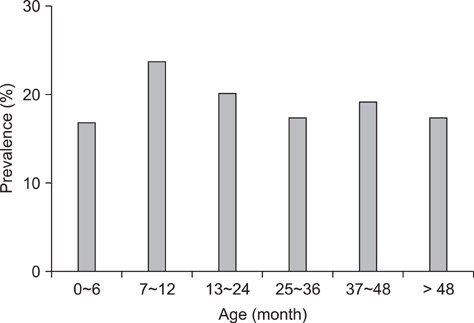J Vet Sci.
2012 Mar;13(1):15-22. 10.4142/jvs.2012.13.1.15.
Prevalence and molecular characterization of Cryptosporidium spp. in dairy cattle from farms in China
- Affiliations
-
- 1College of Veterinary Medicine, Nanjing Agricultural University, Nanjing 210095, China. khhuang@njau.edu.cn
- 2College of Animal Science and Veterinary Medicine, Qingdao Agricultural University, TsingTao 266109, China.
- KMID: 1364998
- DOI: http://doi.org/10.4142/jvs.2012.13.1.15
Abstract
- Fecal samples of 2,056 dairy cattle from 14 farms were collected in three geographical regions of China and stained using a modified acid-fast staining technique to identify Cryptosporidium oocysts. A total of 387 (18.82%) positive samples were identified and further analyzed by polymerase chain reaction (PCR) using primers designed to amplify DNA fragments from the small subunit ribosomal RNA. The PCR products were sequenced and the sequences were deposited in the GenBank database under accession numbers EU369377-84 and GU070730-33. Phylogenetic analysis was performed and a distances matrix generated from these sequences confirmed the existence of Cryptosporidium (C.) parvum 'mouse' genotype, C. bovis, C. andersoni, C. hominis, and C. serpentis in cattle. These results represent the first report on the prevalence and genetic identification of Cryptosporidium species, and may contribute to a better understanding of the epidemiology of Cryptosporidium in cattle in China.
Keyword
MeSH Terms
-
Animals
Base Sequence
Cattle
Cattle Diseases/epidemiology/*parasitology
Chi-Square Distribution
China/epidemiology
Cryptosporidiosis/epidemiology/parasitology/*veterinary
Cryptosporidium/genetics/*isolation & purification
DNA, Protozoan/chemistry/genetics
Feces/parasitology
Female
Molecular Sequence Data
Phylogeny
Polymerase Chain Reaction/veterinary
Prevalence
RNA, Ribosomal, 18S/chemistry/genetics
Sequence Alignment
Sequence Analysis, DNA
Figure
Reference
-
1. Azami M, Moghaddam DD, Salehi R, Salehi M. The identification of Cryptosporidium species (protozoa) in Ifsahan, Iran by PCR-RFLP analysis of the 18S rRNA gene. Mol Biol (Mosk). 2007. 41:934–939.2. Becher KA, Robertson ID, Fraser DM, Palmer DG, Thompson RCA. Molecular epidemiology of Giardia and Cryptosporidium infections in dairy calves originating from three sources in Western Australia. Vet Parasitol. 2004. 123:1–9.
Article3. Brook EJ, Anthony Hart C, French NP, Christley RM. Molecular epidemiology of Cryptosporidium subtypes in cattle in England. Vet J. 2009. 179:378–382.
Article4. Burenbaatar B, Bakheit MA, Plutzer J, Suzuki N, Igarashi I, Ongerth J, Karanis P. Prevalence and genotyping of Cryptosporidium species from farm animals in Mongolia. Parasitol Res. 2008. 102:901–905.
Article5. Castro-Hermida JA, Carro-Corral C, González-Warleta M, Mezo M. Prevalence and intensity of infection of Cryptosporidium spp. and Giardia duodenalis in dairy cattle in Galicia (NW Spain). J Vet Med B Infect Dis Vet Public Health. 2006. 53:244–246.
Article6. Castro-Hermida JA, Almeida A, González-Warleta M, Correia da Costa JM, Rumbo-Lorenzo C, Mezo M. Occurrence of Cryptosporidium parvum and Giardia duodenalis in healthy adult domestic ruminants. Parasitol Res. 2007. 101:1443–1448.
Article7. Chen F, Huang K. Prevalence and phylogenetic analysis of Cryptosporidium in pigs in eastern China. Zoonoses Public Health. 2007. 54:393–400.
Article8. Chen F, Huang K, Qin S, Zhao Y, Pan C. Comparison of viability and infectivity of Cryptosporidium parvum oocysts stored in potassium dichromate solution and chlorinated tap water. Vet Parasitol. 2007. 150:13–17.
Article9. de La Fuente R, Luzón M, Ruiz-Santa-Quiteria JA, García A, Cid D, Orden JA, García S, Sanz R, Gómez-Bautista M. Cryptosporidium and concurrent infections with other major enterophatogens in 1 to 30-day-old diarrheic dairy calves in central Spain. Vet Parasitol. 1999. 80:179–185.
Article10. Duranti A, Cacció SM, Pozio E, Di Egidio A, De Curtis M, Battisti A, Scaramozzino P. Risk factors associated with Cryptosporidium parvum infection in cattle. Zoonoses Public Health. 2009. 56:176–182.11. Fayer R, Morgan U, Upton SJ. Epidemiology of Cryptosporidium: transmission, detection and identification. Int J Parasitol. 2000. 30:1305–1322.
Article12. Fayer R, Santín M, Trout JM, Greiner E. Prevalence of species and genotypes of Cryptosporidium found in 1-2-year-old dairy cattle in the eastern United States. Vet Parasitol. 2006. 135:105–112.
Article13. Fayer R, Santin M, Trout JM. Prevalence of Cryptosporidium species and genotypes in mature dairy cattle on farms in Eastern United States compared with younger cattle from the same locations. Vet Parasitol. 2007. 145:260–266.
Article14. Fayer R. Taxonomy and species delimitation in Cryptosporidium. Exp Parasitol. 2010. 124:90–97.15. Feltus DC, Giddings CW, Khaitsa ML, McEvoy JM. High prevalence of Cryptosporidium bovis and the deer-like genotype in calves compared to mature cows in beef cow-calf operations. Vet Parasitol. 2008. 151:191–195.
Article16. Feng Y, Ortega Y, He G, Das P, Xu M, Zhang X, Fayer R, Gatei W, Cama V, Xiao L. Wide geographic distribution of Cryptosporidium bovis and the deer-like genotype in bovines. Vet Parasitol. 2007. 144:1–9.
Article17. Gow S, Waldner C. An examination of the prevalence of and risk factors for shedding of Cryptosporidium spp. and Giardia spp. in cows and calves from western Canadian cow-calf herds. Vet Parasitol. 2006. 137:50–61.
Article18. Graczyk TK, Fayer R, Cranfield MR. Zoonotic transmission of Cryptosporidium parvum: implications for water-borne cryptosporidiosis. Parasitol Today. 1997. 13:348–351.
Article19. Halim NA, Plutzer J, Bakheit MA, Karanis P. First report of Cryptosporidium deer-like genotype in Malaysian cattle. Vet Parasitol. 2008. 152:325–329.20. Heitman TL, Frederick LM, Viste JR, Guselle NJ, Morgan UM, Thompson RCA, Olson ME. Prevalence of Giardia and Cryptosporidium and characterization of Cryptosporidium spp. isolated from wildlife, human, and agricultural sources in the North Saskatchewan River Basin in Alberta, Canada. Can J Microbiol. 2002. 48:530–541.
Article21. Hoar BR, Atwill ER, Elmi C, Farver TB. An examination of risk factors associated with beef cattle shedding pathogens of potential zoonotic concern. Epidemiol Infect. 2001. 127:147–155.
Article22. Johnson DW, Pieniazek NJ, Griffin DW, Misener L, Rose JB. Development of a PCR protocol for sensitive detection of Cryptosporidium oocysts in water samples. Appl Environ Microbiol. 1995. 61:3849–3855.
Article23. Mohammed HO, Wade SE, Schaaf S. Risk factors associated with Cryptosporidium parvum infection in dairy cattle in southeastern New York State. Vet Parasitol. 1999. 83:1–13.
Article24. Morgan UM, Sturdee AP, Singleton G, Gomez MS, Gracenea M, Torres J, Hamilton SG, Woodside DP, Thompson RC. The Cryptosporidium 'mouse' genotype is conserved across geographic areas. J Clin Microbiol. 1999. 37:1302–1305.
Article25. Morgan-Ryan UM, Fall A, Ward LA, Hijjawi N, Sulaiman I, Fayer R, Thompson RC, Olson M, Lal A, Xiao L. Cryptosporidium hominis n. sp. (Apicomplexa: Cryptosporidiidae) from Homo sapiens. J Eukaryot Microbiol. 2002. 49:433–440.
Article26. Nouri M, Toroghi R. Asymptomatic cryptosporidiosis in cattle and humans in Iran. Vet Rec. 1991. 128:358–359.
Article27. Nuchjangreed C, Boonrod K, Ongerth J, Karanis P. Prevalence and molecular characterization of human and bovine Cryptosporidium isolates in Thailand. Parasitol Res. 2008. 103:1347–1353.
Article28. O'Donoghue PJ. Cryptosporidium and cryptosporidiosis in man and animals. Int J Parasitol. 1995. 25:139–195.29. Olson ME, Thorlakson CL, Deselliers L, Morck DW, McAllister TA. Giardia and Cryptosporidium in Canadian farm animals. Vet Parasitol. 1997. 68:375–381.30. Panciera RJ, Thomassen RW, Garner FM. Cryptosporidial infection in a calf. Vet Pathol. 1971. 8:479–484.
Article31. Quílez J, Sánchez-Acedo C, del Cacho E, Clavel A, Causapé AC. Prevalence of Cryptosporidium and Giardia infections in cattle in Aragón (northeastern Spain). Vet Parasitol. 1996. 66:139–146.
Article32. Santín M, Trout JM, Xiao L, Zhou L, Greiner E, Fayer R. Prevalence and age-related variation of Cryptosporidium species and genotypes in dairy calves. Vet Parasitol. 2004. 122:103–117.33. Scott CA, Smith HV, Mtambo MMA, Gibbs HA. An pidemiological study of Cryptosporidium parvum in two herds of adult beef cattle. Vet Parasitol. 1995. 57:277–288.
Article34. Starkey SR, Wade SE, Schaaf S, Mohammed HO. Incidence of Cryptosporidium parvum in the dairy cattle population in a New York City Watershed. Vet Parasitol. 2005. 131:197–205.
Article35. Suresh P, Rehg JE. Comparative evaluation of several techniques for purification of Cryptosporidium parvum oocysts from rat feces. J Clin Microbiol. 1996. 34:38–40.
Article36. Thompson HP, Dooley JSG, Kenny J, McCoy M, Lowery CJ, Moore JE, Xiao L. Genotypes and subtypes of Cryptosporidium spp. in neonatal calves in Northern Ireland. Parasitol Res. 2007. 100:619–624.
Article37. Tyzzer EE. A sporozoan found in the peptic glands of the common mouse. Proc Soc Exp Biol Med. 1907. 5:12–13.
Article38. Tzipori S. Cryptosporidiosis: laboratory investigations and chemotherapy. Adv Parasitol. 1998. 40:187–221.
Article39. Yan Z, Yang Z, Li X. Current situation of preventing and treating common diseases and development measures in dairy cattle in China. China Dairy Cattle. 2011. 12:47–51.40. Zhou R, Li G, Xiao S, Xia Y, Guo Y. PCR amplification and sequence analyses of ITS-1 rDNA from Cryptosporidium andersoni in dairy cattle. Parasitol Res. 2007. 100:1135–1138.
Article
- Full Text Links
- Actions
-
Cited
- CITED
-
- Close
- Share
- Similar articles
-
- Detection and molecular characteristics of bovine rotavirus A in dairy calves in China
- Molecular Prevalence of Cryptosporidium spp. in Breeding Kennel Dogs
- Identification of Cryptosporidium from Dairy Cattle in Pahang, Malaysia
- Serological prevalence of brucellosis of cattle in selected dairy farms in Bangladesh
- Molecular Prevalence of Cryptosporidium spp. among Companion Birds Kept in Pet Shops in Japan




